
Analysis of individual storm events
A.J. Erickson, P.T. Weiss, J.S. Gulliver, R.M. Hozalski
Summation of load
The summation of load method is used to determine the average reduction of pollutant mass (i.e., load). The sum of the mass load (kilograms or pounds) for both influent and effluent samples can be calculated using equation 7.7 which is applicable to any number of samples (n) that correspond to discharge volume (V) and concentration measurements (C).
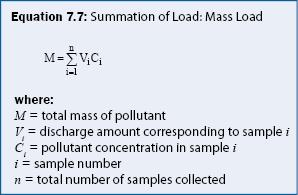
After the influent and effluent loads have been summed, the stormwater treatment practice performance can be calculated based on the summation of load method according to equation 7.8. An example of how to apply the summation of load method to assess stormwater treatment practice removal efficiency using discrete-sampled monitoring data is given in example 7.3. The results can be compared to other storm events for the same stormwater treatment practice, storm events for a different treatment practice, results obtained from other methods of analysis (e.g., event mean concentration efficiency), or they can be combined with other storm event data for the same stormwater treatment practice in an analysis of long-term performance.
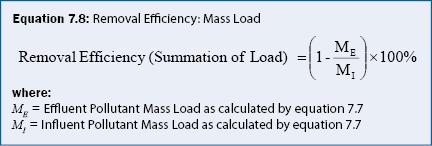
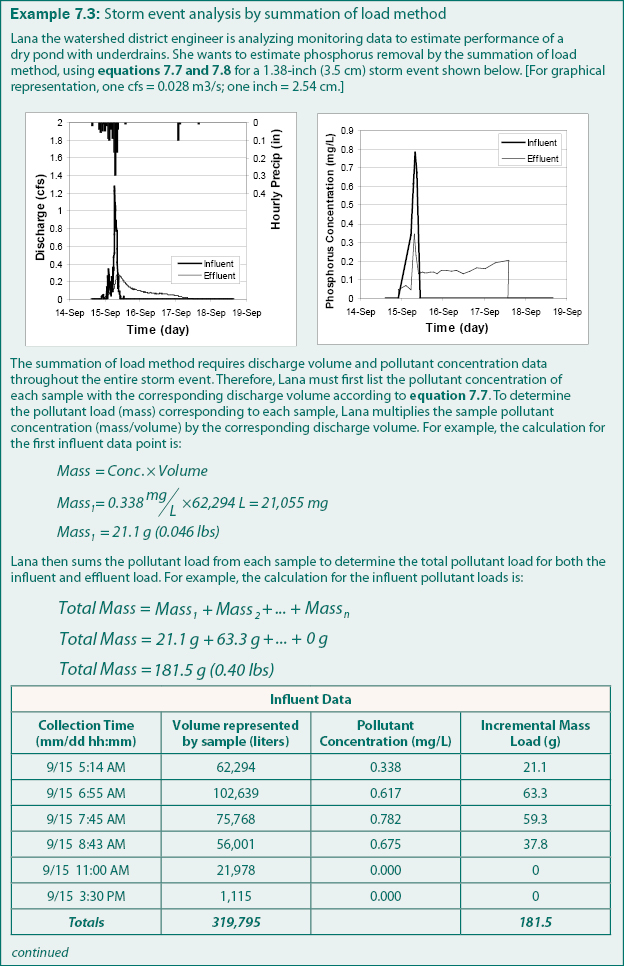
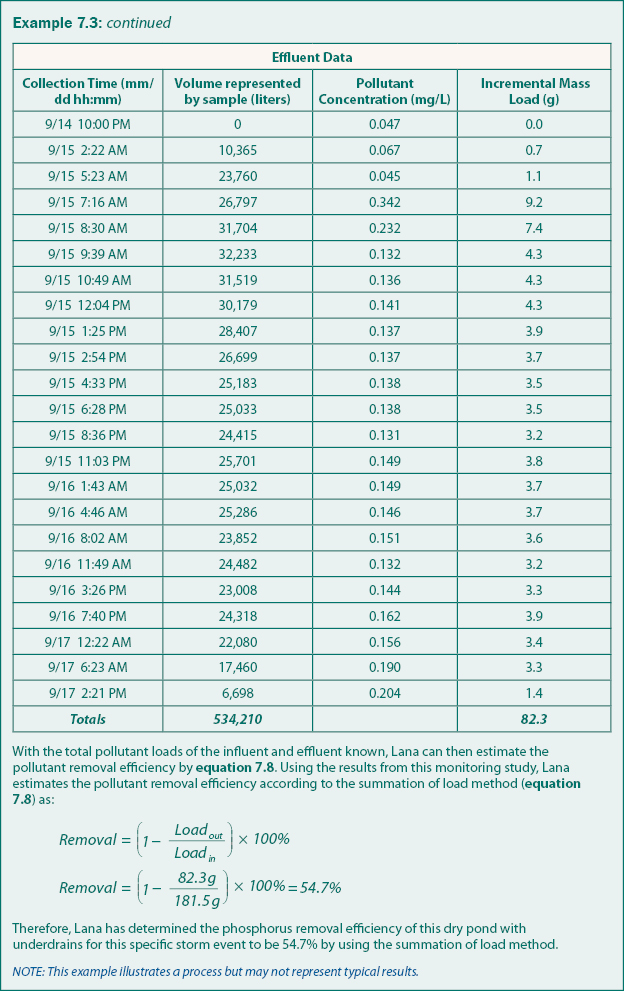
The application of equation 7.7 may depend on the type of samples collected. Therefore, the summation of load method is described for each type of sampling method (e.g., flow-weighted discrete, flow-weighted composite, etc.).
Flow-weighted discrete samples
When samples are collected based on a user-specified constant incremental volume of discharge (e.g., every 1000, 2000, or 5000 gallons) that passes the sampler, the samples are defined as flow-weighted. Each flow-weighted sample is assumed to represent the average pollutant concentration for the entire incremental volume of water to which it corresponds. Each discrete sample is stored in an individual container, and the contents of each container are analyzed separately. Equation 7.7 can be simplified if flow-weighted discrete samples are collected because the volume increment (Vi) is the same for each sample. Therefore, the summation of load method for flow-weighted discrete samples can be calculated using equation 7.10.
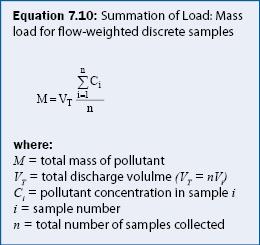
Flow-weighted composite samples
Flow-weighted composite samples are collected every time a user-specified constant volume of flow passes the sampler and all samples are stored in a single container. To determine pollutant concentration, an aliquot is collected from the composite sample, and the concentration is assumed to represent that of the entire composite sample. Equation 7.7 can be simplified if flow-weighted composite samples are collected because the volume increment (Vi) is the same for each sample, and the composite sample concentration is a volume-weighted average of all the individual samples that were taken. Therefore, the summation of load method for flow-weighted composite samples can be calculated using equation 7.11.
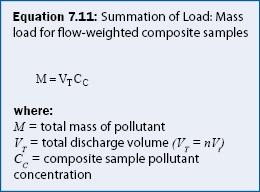
Time-weighted discrete samples
Time-weighted discrete samples are collected at a user-specified, constant time interval (e.g., 30 minutes), and each sample is stored in a separate container and analyzed separately. Because the magnitude of the discharge during a natural storm event varies over time, each time-weighted sample does not represent a constant volume of discharge. Equation 7.7 cannot be simplified if time-weighted discrete samples are collected because the volume increment (Vi) and concentrations of the discrete samples (Ci) will vary. Therefore, equation 7.7 must be used.
Time-weighted composite samples
Time-weighted composite samples are collected at equal time increments, and all samples are stored in a single container. For reasons discussed in Sampling Methods, time-weighted composite sampling is not recommended.
Discrete grab samples
A grab sample is a single sample collected at one location over a relatively short time period, typically sampling the entire cross-section of water. Discharge must be accurately and continuously measured and the time of each grab sample must be recorded to assess pollutant removal performance. Discrete samples are stored in individual containers, and the contents of each container are analyzed separately. Equation 7.7 must be used if time-weighted discrete samples are collected because the volume increment (Vi) and concentrations of the discrete samples (Ci) will vary.
Composite grab samples
Composite grab samples are typically collected at variable time and volume increments and stored in a single sample storage container. For reasons discussed in Sampling Methods, composite grab sampling is not recommended.
Event mean concentration efficiency
The event mean concentration (EMC) efficiency method is used to determine the average reduction in pollutant concentration for a given stormwater treatment practice. EMC in units of mass per volume (e.g., mg/L) can be calculated using equation 7.12, which is applicable to any number of samples within a storm event. When comparing equations 7.7 and 7.12, it is apparent that EMC can be calculated simply by dividing the total mass of pollutant (equation 7.7) by the total volume of stormwater.
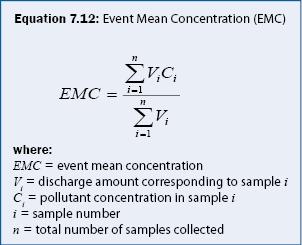
After the influent and effluent EMC has been calculated, the EMC efficiency of the stormwater treatment practice can be calculated using equation 7.13. This process is demonstrated for discrete–sampled monitoring data in example 7.4. After storm event data have been analyzed, they can be compared to other storm events for the same stormwater treatment practice, storm events for a different treatment practice, results obtained from other methods of analysis (e.g., summation of load), or they can be combined with other storm event data for the same stormwater treatment practice to analyze long-term performance.
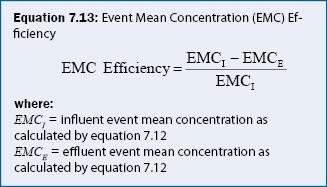
The total volume of stormwater entering and exiting the treatment practice must be accounted for in the calculation of EMC. The influent EMC is determined by summing the influent mass load and dividing by the total influent stormwater volume as described by equation 7.12. The influent EMC must then be adjusted to account for rain that falls directly onto the stormwater treatment practice by multiplying the influent EMC by the ratio of measured influent volume to the sum of measured influent and the volume of rainfall (equation 7.14). This process is also demonstrated in example 7.4 for discrete–sampled monitoring data. This procedure assumes that the rainfall contains no pollutant and is well-mixed with the stormwater stored in the treatment practice.
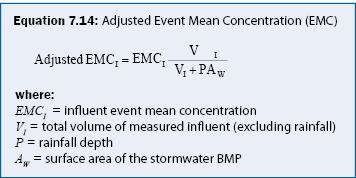
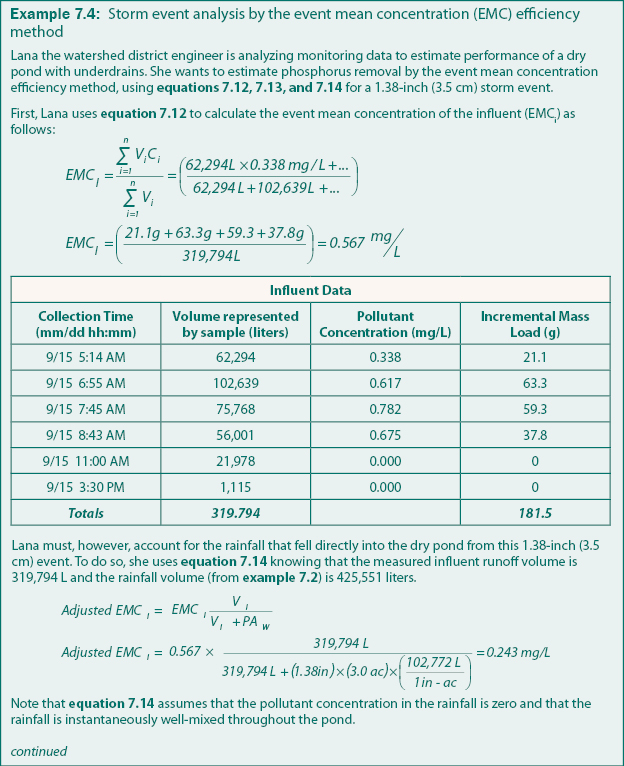
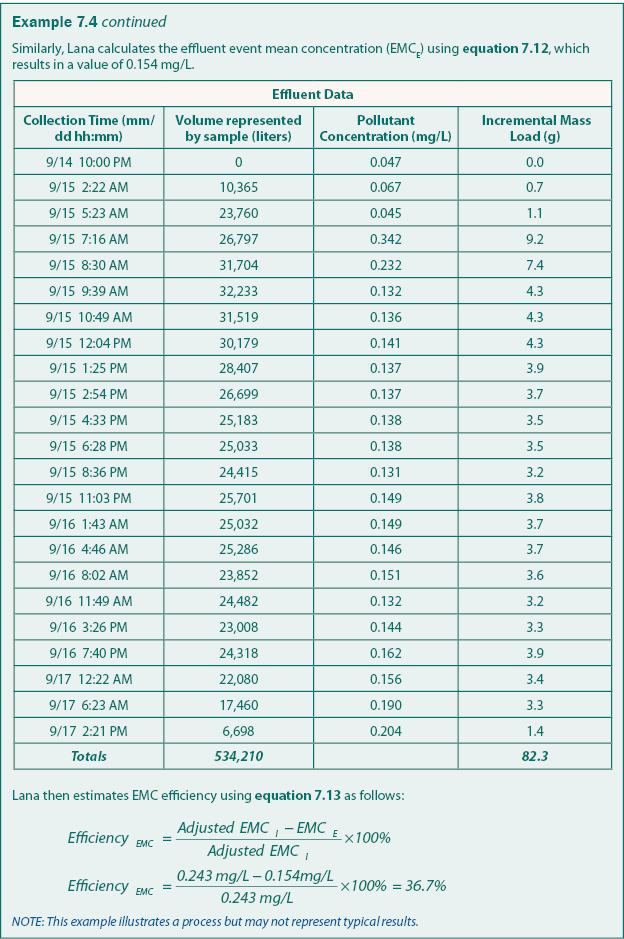
Note that when the EMC efficiency method (example 7.4) is used to analyze the same data as the summation of load method (example 7.3), the results are different. The summation of load method is based on only the total mass of pollutant that enters and exits the stormwater treatment practice whereas the event mean concentration efficiency method is based on the pollutant concentration entering and exiting the stormwater treatment practice. The difference arises between the two methods because samples are collected at monitored locations and the volume of runoff entering through monitored inlets is usually different than the volume leaving through monitored outlets due to direct rainfall, infiltration, and evapotranspiration. For example, if an infiltration practice infiltrates half of the influent runoff volume while half of the influent pollutant mass load is retained by the practice (e.g., solids filtered at the soil surface), the efficiency would be 50% based on the summation of load method. For the same case, the EMC of the effluent would be equal to the EMC of the influent (assuming no direct rainfall onto the practice), and the EMC efficiency would be zero.
Flow-weighted discrete samples
Flow-weighted discrete samples are collected every time a user-specified constant volume of flow passes the sampler and are stored in individual containers that are analyzed separately. Equation 7.12 can be simplified if flow-weighted discrete samples are collected because the volume increment (Vi) is the same for each sample and the summation of the volumes is equal to the total volume. Therefore, the EMC for flow-weighted discrete samples can be calculated using equation 7.15.
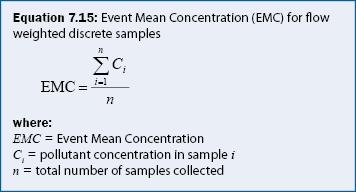
Flow-weighted composite samples
Flow-weighted composite samples are collected at equal volumes of stormwater runoff and stored in a single container. Equation 7.12 can be simplified for flow-weighted composite samples because the volume increment (Vi) is the same for each sample and the composite sample concentration is a volume-weighted average of all the individual samples that were taken. Therefore, the EMC for flow-weighted composite samples is simply the concentration of the composite sample (Cc).
Time-weighted discrete samples
Time-weighted discrete samples are collected at equal time increments, stored in individual containers, and analyzed separately. Equation 7.12 cannot be simplified if time-weighted discrete samples are collected because the volume increment (Vi) and concentrations of the discrete samples (Ci) will vary, and therefore equation 7.12 must be used.
Time-weighted composite samples
Time-weighted composite samples are collected at equal time increments, and all samples are stored in a single container. For reasons discussed in Sampling Methods, time-weighted composite sampling is not recommended.
Discrete grab samples
Discrete grab samples are typically collected at variable time and volume increments, stored in individual containers, and analyzed separately. A stop watch may be used to minimize the variability in time intervals between sample collection. Equation 7.12 cannot be simplified if time-weighted discrete samples are collected because the volume increment (Vi) and concentrations of the discrete samples (Ci) will vary and therefore equation 7.12 must be used.
Composite grab samples
Composite grab samples are typically collected at variable time and volume increments and stored in a single sample storage container. For reasons discussed in Sampling Methods, composite grab sampling is not recommended.
Continue to Analysis of long-term performance.